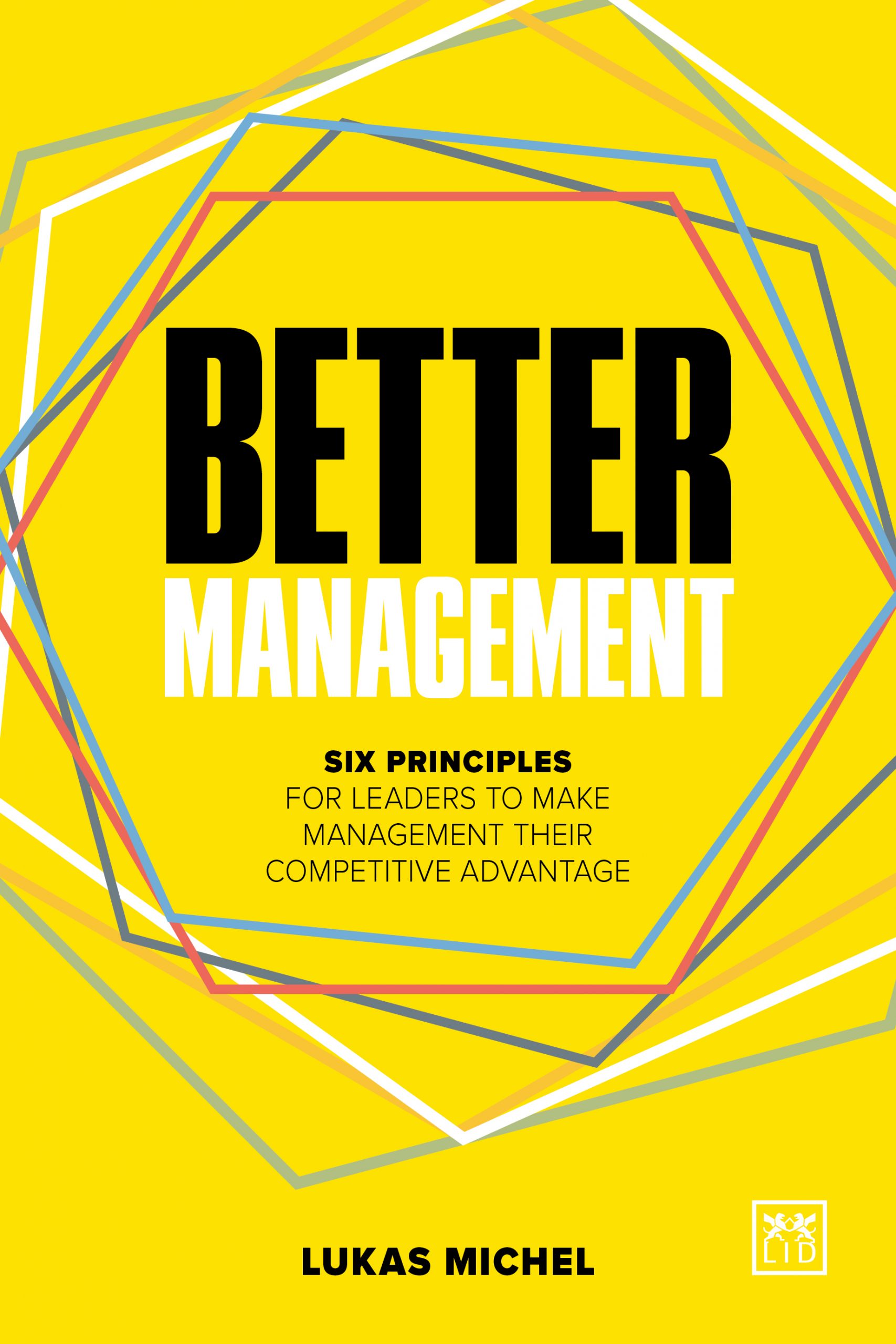|
What Are the Six Principles That Make Management a Competitive Advantage? by Lukas Michel
By Guest Contributor Lukas Michel
Author of Better Management, Lukas Michel, explains what are the six principles that will make management your competitive advantage.
To be a true differentiator, management needs to fulfil the criteria of a competitive advantage. In line with strategic management professor Jay B Barney’s resource-based view of the firm and the VRIN criteria for competitive advantage (valuable, rare, inimitable and nonsubstitutable), our research has identified a model with six features to signal whether management qualifies as a competitive advantage.
Better is the standard that qualifies management as a competitive advantage. The standard comes in steps that are increasingly demanding, have greater impact and offer higher sustainability:
- A viruses-free, collaborative, connected, and purposeful work environment for people to get work done.
- A strategy with agile capabilities that safeguards performance, innovation, and growth for the organization to be successful and create value.
- People-centric management with principles for self-responsible people who make the client offering specific.
- People who play the inner game experience flow, which makes performance hard to copy.
- An operating system with dynamic principles that allows no shortcuts.
- A toolbox with diagnostic systems for interactive leadership that is deeply embedded in culture.
Management must fulfil all six criteria to qualify as a competitive advantage.
The criteria and their components are as follows:
Does the work environment enable people to get work done? Our model uses culture, purpose, relationships, and collaboration to size up the work environment. An engaging work environment is a competitive advantage because it enables people to get work done.
Does your organization keep promises and create value? Our model uses performance, innovation, growth, and success to determine organizational outcomes and reveal whether management creates value. Keeping promises is a competitive advantage because it establishes trust with clients, which is of greatest value.
Does your management create unique value? Our model uses ten questions to review whether management applies a control-based (traditional management) or an enabling-based (people-centric management) approach to leading people. A people-centric management approach is a competitive advantage because it mobilizes resources in ways that make the client offering specific.
Do people use their talent to exceed expectations? Our model uses awareness, trust, choice, and focus of attention as the means for people to experience flow, perform at their peak and learn. Achieving flow more often – the state of high performance – is a competitive advantage that is hard to copy.
Is your operating system ready for VUCA (Volatility, Uncertainty, Complexity, Ambiguity)? Our model reviews the operating system to evaluate whether it has a design for a traditional or a dynamic environment. A dynamic operating system is a competitive advantage, as it prevents shortcuts.
Is your toolbox deeply embedded in culture? Our model looks at systems and leadership with interactive and diagnostic features. Their usage tells us whether the toolbox is rooted in the culture and is a competitive advantage.
What can you do to reach the better standards?
- Work environment: Remove the interference and offer the opportunity.
- Strategy and results: Develop agile capabilities and clear expectations.
- Management: Engage in people-centric principles for people to mobilize their resources.
- People: Enable people to play the inner game for them to unfold their potential.
- Operating System: Insist on dynamic features in support of people to master higher challenges.
- Toolbox: Maintain a diagnostic toolbox for people to capture new opportunities and grow.
Every executive, organization, and operating system is unique. That’s why diagnostic mentoring uses a diagnostic to monitor capabilities, applies the inner-game techniques for expedited learning, uses visual thinking aids to offer options, facilitates conversations with the canvas and guides management with the people-centric cycle. It’s the process that uses experience, suggests principles and guides the transformation to Better Management. Better Management means leadership everywhere. It’s a team process that simultaneously works on the system while people work in the system.
With these six features, Better Management turns into a competitive advantage. Companies that have established agile, people-centric and dynamic capabilities outperform others by a huge margin. And, once developed, these capabilities permeate the entire organization – deeply embedded into the culture of the organization. They are a true competitive advantage that is hard to copy. That’s why every manager needs to worry about Better Management.
Why guess if you can know. Better Management comes with a diagnostic tool for managers to review six principles that make up management as a competitive advantage. Learn more to set your standards: https://management-insights.ch/en/diagnostics/better-management
ABOUT THE AUTHOR

LUKAS MICHEL is the owner of Agility Insights AG, based in Switzerland, and CEO of Lukas Michel Management Insights, a global network of experienced business mentors. Over the course of his 40-year career, he has worked with executive teams around the world, focusing on management and agility for a diverse range of local, national,and global organizations. Lukas is the author of The Performance Triangle, Management Design, People-Centric Management and Diagnostic Mentoring.
LinkedIn: https://www.linkedin.com/in/lukasmichel/
Suggested Reading
 For management to be a competitive advantage, it must be better management. Recent research has shown that companies that have established agile, people-centric and dynamic capabilities – and have got rid of traditional management methods – outperform others by a huge margin. From this, the author offers six key principles of better management, that will provide the platform for all business leaders and organizations to make the shift towards greater performance.
For management to be a competitive advantage, it must be better management. Recent research has shown that companies that have established agile, people-centric and dynamic capabilities – and have got rid of traditional management methods – outperform others by a huge margin. From this, the author offers six key principles of better management, that will provide the platform for all business leaders and organizations to make the shift towards greater performance.
Other books by the author
 It’s every manager’s prime job to manage better: to change the way they lead people and how they organise work in the new (post-pandemic) business context. The book discusses the role of the operating system to do that and clarifies managerial priorities and goals. This then sets the stage for Diagnostic Mentoring – the methodology that enables the transformation of the way we manage.
It’s every manager’s prime job to manage better: to change the way they lead people and how they organise work in the new (post-pandemic) business context. The book discusses the role of the operating system to do that and clarifies managerial priorities and goals. This then sets the stage for Diagnostic Mentoring – the methodology that enables the transformation of the way we manage.
 Management in turbulent times needs greater vision and foresight. This book offers an exciting visual-thinking approach to help managers, leaders and entrepreneurs think through their options and find a way that best meets the needs of their businesses, that supports their talent to perform at their peak, and simultaneously builds the capabilities to cope with turbulent times.
Management in turbulent times needs greater vision and foresight. This book offers an exciting visual-thinking approach to help managers, leaders and entrepreneurs think through their options and find a way that best meets the needs of their businesses, that supports their talent to perform at their peak, and simultaneously builds the capabilities to cope with turbulent times.
 If you have not yet experienced the benefits of agile but don’t want to miss the trend, then Agile by Choice offers a gentle introduction into the core concept and the prerequisite of people-centric management. This book offers a new way to think about how you lead people, how you use your own resources, and how you personally perform at your peak.In line with his previous books, Lukas Michel presents a diagnostic self-mentoring approach with 21 exercises for leaders to learn about agile and people centric. This book initiates the shift to strategic agility with your team to establish leadership everywhere.
If you have not yet experienced the benefits of agile but don’t want to miss the trend, then Agile by Choice offers a gentle introduction into the core concept and the prerequisite of people-centric management. This book offers a new way to think about how you lead people, how you use your own resources, and how you personally perform at your peak.In line with his previous books, Lukas Michel presents a diagnostic self-mentoring approach with 21 exercises for leaders to learn about agile and people centric. This book initiates the shift to strategic agility with your team to establish leadership everywhere.
 Today’s dynamic business environment requires new ways to man- age, lead, work, and organize. Traditional paradigms of efficiency, agency theory, transactions and scale are replaced or augmented with principles that focus on people, self-organization, and purpose for greater innovation and growth.
Today’s dynamic business environment requires new ways to man- age, lead, work, and organize. Traditional paradigms of efficiency, agency theory, transactions and scale are replaced or augmented with principles that focus on people, self-organization, and purpose for greater innovation and growth.
To expand on his previous books, Lukas Michel presents new research, practical applications and the experience with People- Centric Management, agile organization and work on the system to establish new management where people unlock their talent, master greater challenges and perform at their peak.
The book offers the legendary People-Centric Diagnostic that forces the reader to decode and rethink the many assumptions underlying their management model and systems. In combination, the people-centric model, the three-step process and action agenda will help executives establish leadership everywhere to succeed in a dynamic environment.

It is a new era. To win in an increasingly dynamic and volatile environment, leadership teams must be agile – they must be flexible enough to react to early signs and act on them quickly.
An agile company needs good decision-making at all levels – from the centre to the periphery, tapping into the full potential of the people, operating model, information technology and leadership practices. And decisions are made by people. This guide forces you to re-examine the assumptions underlying your leadership and how agility within your company can be built through a three-point, people-centric approach. The author’s insights will help you understand your options, make the choices required to successfully coach your team, and start creating agility as a competitive advantage today.
